Main page
About us
Sliding Bearings Consulting
Advertising Opportunities

SubsTech’s sister website Smooth Sliding provides independent engineering consulting services that help you to solve engine bearing related issues: failures, material selection, geometry design and optimization of hydrodynamic conditions.
Smooth Sliding is an engineering consulting company run by Dr. Dmitri Kopeliovich:
- VP R&D of King Engine Bearings.
- World leading expert (32 years of experience) in design, technology and materials for Engine bearings in applications such as automotive, renewable energy, aviation, racing and others.
- Founder and owner of SubsTech (Substances & Technologies) – a leading professional website on Materials Science and Engineering.
- Author of numerous scientific and engineering publications and patents.
- Founder and owner of Smooth Sliding.
For further information and for requesting consulting services please visit our sister website Smooth Sliding.
to Metals
to Engine bearings
Manufacturing bi-metal strips for aluminum bearings
Dr. Dmitri Kopeliovich
Most Aluminum based bearing materials have bi-metal structure: aluminum alloy bonded to a steel back.
Bonding of the two layers is performed by cold Rolling of a continuously cast strip of aluminum bearing alloy together with a strip of low carbon steel (carbon 0.08-0.12%).
Technology of manufacturing bi-metal strips for aluminum bearings:
Annealing cast strips of aluminum bearing alloys
Most methods of Continuous casting of aluminum based bearing alloys result in internal stresses therefore the castings should be annealed prior to cladding.
to top
Cladding aluminum bearing alloy with pure aluminum
Tin contained in aluminum bearing alloys prevents achievement of good adhesion between the bonded strips.
The most popular method to avoid the adverse effect of tin is cladding aluminum strip with a bonding layer of pure aluminum (technically pure alloy with 99.5-99.7% Al, eg. 1060) prior to steel backing.
Two pure aluminum layers may be clad from both sides of the casting: the bonding layer and the protection layer preventing tin “sweating” on the aluminum surface during the final annealing of the bi-metal strip.
Prior to the cladding operation the coiled strip of pure aluminum is degreased, mechanically cleaned and brushed in a cleaning line where the aluminum strip passes through a solvent degreaser, vapors of which dissolve oils (commonly protection oils) on the strip surface.
Chlorinated solvents such as Trichlorethylene, Methylene chloride or Perchlorethylene are commonly used in vapor degreasers.
Degreased strip is cleaned by rotating steel wire circular brushes and re-coiled on drums. Only the surface, which is to be bonded to the alloy strip is brushed.
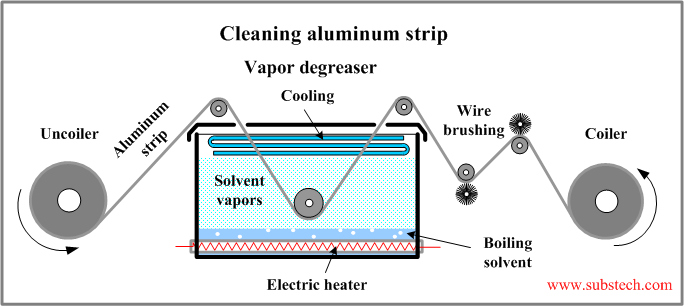
Coils of clean aluminum strip are transferred to the cladding line.
A coil of a continuously cast strip of aluminum bearing alloy is installed on the uncoiler. The casting surface should be clean, contains no oil residuals and no cast defects.
Clean and annealed cast strip is uncoiled, straightened and brushed from both sides by steel wire circular brushes, which remove oxide film, residuals of burnt oil and other foreign substances.
Simultaneously two strips of pure aluminum are also un-coiled.
Three strips enter the rolling mill where they adhere to each other as a result of Solid State Welding (SSW). The pressure necessary for achievement of bonding is obtained at relatively high thickness reduction for on-pass rolling operation.
The second rolling pass with lower thickness reduction provides stable bonding with the value of adhesion stress close to the tensile strength of aluminum.
Two-high rolling mills are used for aluminum cladding operations.
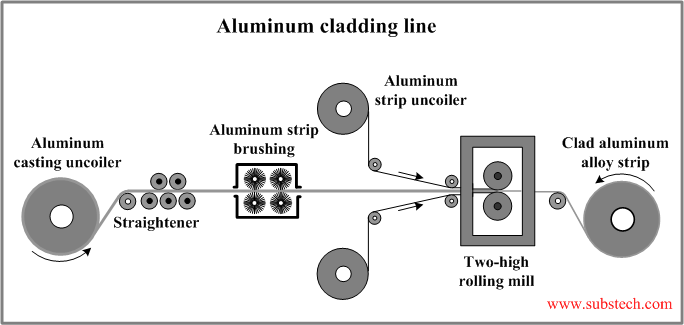
to top
Rolling aluminum strip
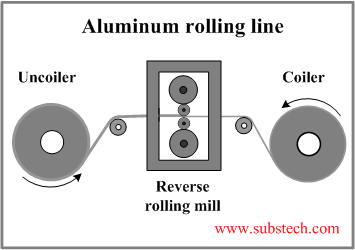
The strip of aluminum alloy clad with pure aluminum is then cold rolled to the final thickness for several rolling passes prior to bonding with steel back.
Reverse rolling mills (either two-high or four-high) are used for rolling aluminum strips.
After the final thickness of the aluminum strip has been achieved it is cut by a slitter in order to remove defective edges and produce the required strip width.
to top
Roll bonding aluminum and steel strips
Prior to bonding with steel clad aluminum strip is degreased, mechanically cleaned and brushed by rotating circular brushes (either nylon or steel) in a cleaning line where the aluminum strip passes through a solvent degreaser (similar to the line for cleaning pure aluminum strip).
The drum with the coil of clean strip of aluminum bearing alloy is then installed on the bonding line.
Coil of a steel strip is installed on the uncoiler of the bonding line. The steel strip is uncoiled straightened, cleaned by circular rotating brushes in the washing unit using a hot alkaline solution and then grinded by rotating abrasive belts.
In parallel the aluminum alloy strip is uncoiled and brushed by steel wire rotating circular brushes (only the surface, which is to be bonded to the steel strip is brushed).
Two strips enter rolling mill where they adhere to each other as a result of Solid State Welding (SSW). The pressure necessary for achievement of bonding is obtained at relatively high thickness reduction for on-pass rolling operation.
Four-high rolling mills are used for bonding aluminum alloy with steel strip.
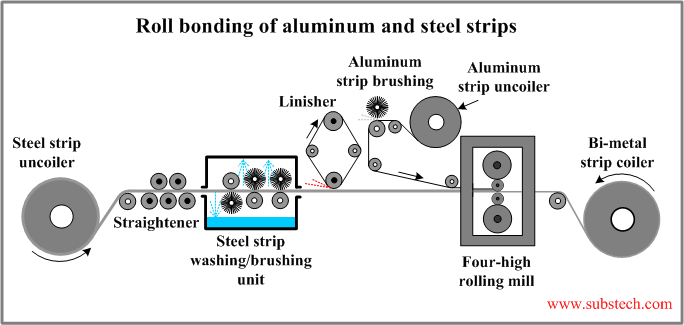
Another version of roll bonding technology is presented in the scheme below.
Steel strip here is preheated in an induction heated tunnel just before entering three-high rolling mill. The line permits to bond steel strip with non-clad aluminum alloy with relatively low tin content (up to 8%), which was cast on twin-roll caster, annealed and then rolled to the required thickness.
Bonding of non-clad aluminum alloys containing higher tin concentrations (eg. 20%) to steel strips is possible if the steel surface is coated by nickel (Nickel electroplating), which serves as a bonding layer.
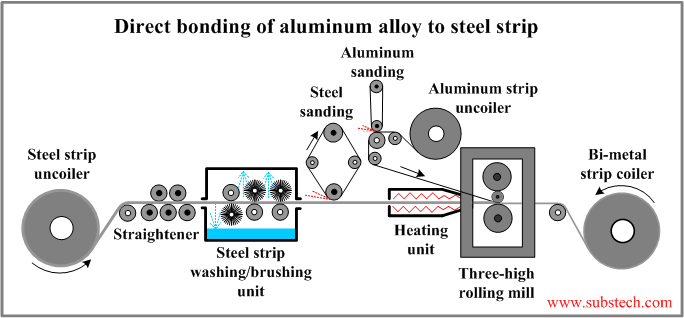
to top
Annealing bi-metal strips
Aluminum bearing alloy on the bonded bi-metal strips has internal stresses and the stress on the boundary between the aluminum and steel strip. The stresses may lead to the bearings failure therefore stress relief operation of the bonded strips is necessary.
In addition to this the aluminum grains and tin plates adjacent to the grains surfaces are elongated along the Rolling direction. Such microstructure is anisotropic with low strength in the direction perpendicular to the rolling direction. Isotropic microstructure may be obtained as a result of recrystallization.
Full annealing of the aluminum alloy bonded to steel strip provides both stress-relief and recrystallization. Full annealing also changes the tin configuration, which converts into reticular (network) structure.
to top
Inspection of bi-metal strips
Inspection is the final stage of manufacturing bi-metal strips for aluminum bearings.
The bi-metal coil after annealing heat treatment is installed onto the inspection line where the strip is cleaned, checked, oiled and recoiled.
The strip is uncoiled then the tin “sweating” at the edges is removed, after which the steel and aluminum surfaces are brushed by rotating circular steel brushes.
Adhesion is tested by chisel and then the strip thickness is checked by a continuous thickness measurement appliance.
The defected parts are marked, the strip is oiled by a Rust protection oils and recoiled.
to top
Related internal links
to Metals
to Engine bearings


